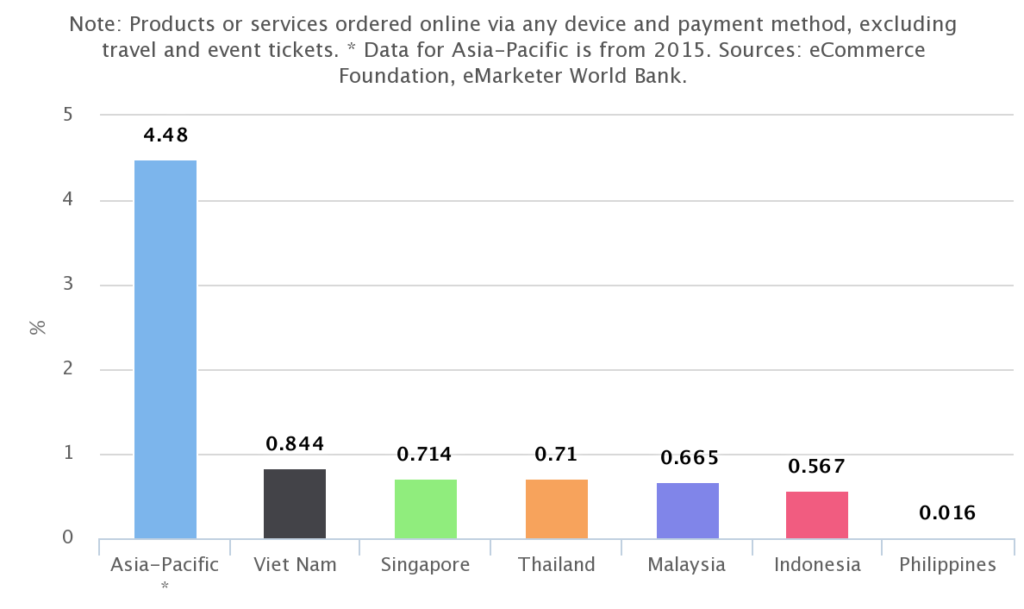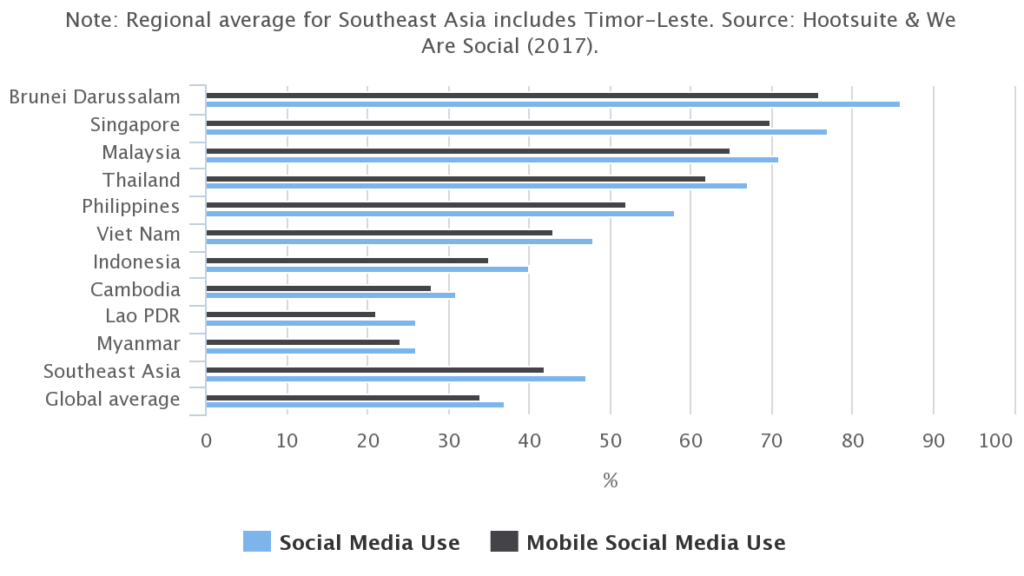How To Maximize E-Commerce in Southeast Asia

Commuters look at their smartphones on a crowded train during morning rush hour in Bangkok. In Thailand, 51 percent of online shoppers have purchased goods directly via a social media channel.
Photo credit: Nicolas Asfouri/AFP/Getty Images
E-commerce in Asia and the Pacific is booming. It is already the world’s largest retail e-commerce market with the bulk of sales (47 percent) coming from China, but total sales are expected to almost triple from $1 trillion in 2016 to $2.7 trillion in 2020. The main drivers of this are an expanding middle class, rapidly increasing mobile and Internet penetration, growing competition among sellers, and improving logistics and infrastructure.
However, recent ADB research shows that Southeast Asia is lagging far behind the rest of the region. In Southeast Asia, the e-commerce market is still at a nascent stage (see Exhibit 1), due to underdeveloped digital payments infrastructure and a weak logistics framework.
Exhibit 1: Share of e-commerce in GDP (%)
 The share of companies in Southeast Asia that have their own websites and use email to communicate with clients—an important element of B2C (business-to-consumer) interactions, which comprise almost 50 percent of e-commerce turnover—are both well below the Asian average.
The share of companies in Southeast Asia that have their own websites and use email to communicate with clients—an important element of B2C (business-to-consumer) interactions, which comprise almost 50 percent of e-commerce turnover—are both well below the Asian average.
But this will soon change, thanks to social media.
Social commerce—sales driven by social media—is a potential game-changer for e-commerce in Southeast Asia. It accounted for 30 percent of all online sales in the region in 2016 and will likely increase its share in the coming years.
Social media platforms offer greater accessibility, more dynamic elements, and cost-efficiency benefits compared to email blasts and online stores. These benefits are particularly vital for small- and medium-sized enterprises and users with limited resources and expertise to maintain websites.
In Thailand, the world’s biggest social commerce market, 51 percent of online shoppers have purchased goods directly via a social media channel. In Malaysia and Indonesia, every third online shopper connects to a social media network to purchase goods.
Social Media Users Going Mobile
It is Southeast Asia’s relatively young population and improved access to the Internet on mobile devices that propels the growth in social commerce. According to a 2017 study by Hootsuite and We Are Social, about 47 percent (306 million) of people in Southeast Asia are active social media users. 42 percent of the population (273 million) accesses social media networks via mobile devices.
Exhibit: Social media penetration (% of monthly active accounts, compared to population)
Seven Southeast Asian countries have social media penetration rates higher than the global average of 37 percent: Brunei Darussalam, Singapore, Malaysia, Thailand, the Philippines, Vietnam and Indonesia. In fact, the growth in the number of active social media users in these countries between January 2016 and January 2017 is above 20 percent.
Indonesia (39 percent), the Philippines (32 percent), and Vietnam (41 percent) are ranked among the top ten countries with the highest growth of mobile social media users during the same period.
So, could social media be the future of online retail in the region? Facebook and Instagram, for instance, could become the preferred platform for SMEs. Pinterest and Twitter are also emerging niche players, despite their relatively smaller user base.
Creating an Environment Conducive to Growth
For social commerce to be successful in the future, it is imperative to develop the necessary market infrastructure and legal frameworks to facilitate transactions. One solution to unlock the region’s e-commerce potential could be messaging apps. By engaging customers directly online and making business communications more private, these apps could help build consumer trust in the online transaction process and partly address the lack of security and confidence around online payments and delivery.
Low levels of financial account ownership and credit/debit card penetration in Southeast Asian economies remain a huge challenge. Currently, e-commerce remains largely domestic. Ultimately, for social media to encourage more cross-border e-commerce, Southeast Asia must significantly expand consumer access to advanced payment systems that operate in several countries and develop a robust shipping network.
Finally, SMEs and local startups could be the prime beneficiary of social commerce through reduced costs and improved market access both domestically and across borders. Here are four key policy recommendations for Southeast Asian countries eager to capitalize on social media for e-commerce:
- boost market access by removing barriers to digital trade;
- introduce legal, regulatory and institutional reforms to accommodate electronic business, facilitate access and connectivity, and enable e-payments;
- foster an enabling environment for digital businesses through investment, especially in local startup networks/ecosystems; and
- improve the availability and quality of connectivity infrastructure.
This piece first appeared on the Asian Development Bank’s Agenda blog.





